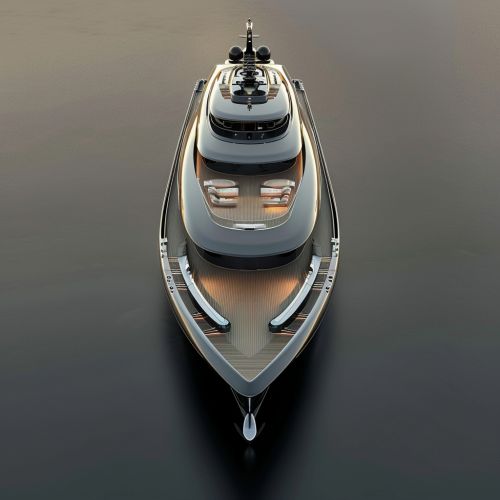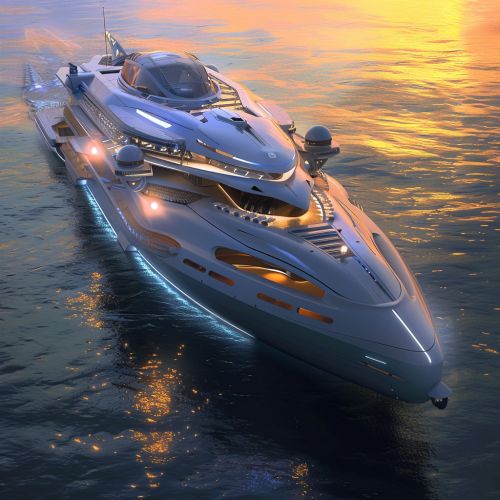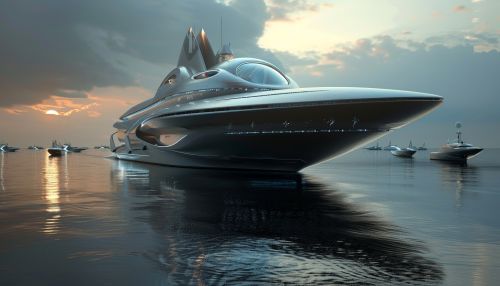Naval Engineering: Difference between revisions
No edit summary |
No edit summary |
||
| (One intermediate revision by the same user not shown) | |||
| Line 48: | Line 48: | ||
The future of naval engineering is expected to be shaped by several key trends. These trends include the increasing use of digital technologies in ship design and construction, the growing importance of sustainable and renewable energy sources in marine propulsion, and the increasing demand for autonomous and remotely operated vessels. | The future of naval engineering is expected to be shaped by several key trends. These trends include the increasing use of digital technologies in ship design and construction, the growing importance of sustainable and renewable energy sources in marine propulsion, and the increasing demand for autonomous and remotely operated vessels. | ||
[[Image:Detail-77783.jpg|thumb|center|A futuristic ship, showcasing the potential future developments in naval engineering.|class=only_on_mobile]] | |||
[[Image:Detail-77784.jpg|thumb|center|A futuristic ship, showcasing the potential future developments in naval engineering.|class=only_on_desktop]] | |||
== See Also == | == See Also == | ||
Latest revision as of 19:04, 7 May 2024
Introduction
Naval engineering, a branch of engineering, is associated with the design, construction, and maintenance of marine vessels and structures. This field of engineering is responsible for the development of ships, submarines, oil rigs, and any other marine vessel or structure. Naval engineering also includes the study of the effects of the ocean environment on ships and other marine vessels and structures.
History
Naval engineering has a rich history that dates back to the ancient civilizations of Egypt and Greece. The Egyptians were known for their advanced shipbuilding techniques, while the Greeks were renowned for their innovative naval designs. The Romans also contributed significantly to the development of naval engineering with their advanced naval architecture and shipbuilding techniques.


During the Middle Ages, the field of naval engineering saw significant advancements with the introduction of new shipbuilding materials and techniques. The Industrial Revolution in the 18th and 19th centuries brought about further advancements in naval engineering, with the development of steam-powered ships and the introduction of iron and steel in ship construction.
In the 20th century, naval engineering saw rapid advancements with the development of nuclear-powered submarines and aircraft carriers, as well as the introduction of computer-aided design (CAD) and other advanced technologies in the design and construction of marine vessels and structures.
Naval engineering is based on a number of fundamental principles. These principles include hydrostatics, hydrodynamics, naval architecture, marine engineering, and ocean engineering.
Hydrostatics
Hydrostatics is the study of fluids at rest. In naval engineering, hydrostatics is used to calculate the buoyancy of a ship or other marine structure. This involves determining the weight of the vessel and the volume of water it displaces when it is at rest in the water.
Hydrodynamics
Hydrodynamics is the study of fluids in motion. In naval engineering, hydrodynamics is used to calculate the resistance of a ship or other marine structure as it moves through the water. This involves determining the forces acting on the vessel as it moves and the effects of these forces on the vessel's speed and maneuverability.
Naval architecture is the science of designing and constructing ships and other marine structures. This involves the application of engineering principles to the design of the hull, superstructure, and other components of a ship or other marine structure.
Marine Engineering
Marine engineering involves the design, construction, and maintenance of the mechanical and electrical systems of a ship or other marine structure. This includes the propulsion system, electrical system, and other systems that are essential for the operation of the vessel.
Ocean Engineering
Ocean engineering involves the design and construction of offshore structures, such as oil rigs and wind farms. This involves the application of engineering principles to the design and construction of structures that can withstand the harsh conditions of the ocean environment.
Naval engineering is a broad field that encompasses several disciplines. These disciplines include naval architecture, marine engineering, and ocean engineering.
Naval architecture is the discipline of naval engineering that deals with the design of ships and other marine vessels. Naval architects are responsible for the overall design of the vessel, including the hull, superstructure, and other components. They must ensure that the vessel is stable, seaworthy, and efficient.


Marine Engineering
Marine engineering is the discipline of naval engineering that deals with the mechanical and electrical systems of a ship or other marine vessel. Marine engineers are responsible for the design, construction, and maintenance of these systems. They must ensure that the systems are reliable, efficient, and safe.
Ocean Engineering
Ocean engineering is the discipline of naval engineering that deals with the design and construction of offshore structures. Ocean engineers are responsible for the design, construction, and maintenance of these structures. They must ensure that the structures can withstand the harsh conditions of the ocean environment.
The future of naval engineering is expected to be shaped by several key trends. These trends include the increasing use of digital technologies in ship design and construction, the growing importance of sustainable and renewable energy sources in marine propulsion, and the increasing demand for autonomous and remotely operated vessels.


